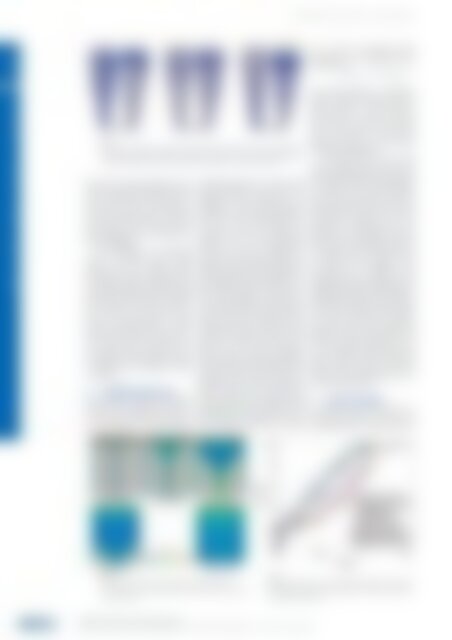Create successful ePaper yourself
Turn your PDF publications into a flip-book with our unique Google optimized e-Paper software.
<strong>atw</strong> Vol. 63 (<strong>2018</strong>) | Issue 8/9 ı August/September<br />
470<br />
AMNT <strong>2018</strong> | YOUNG SCIENTISTS' WORKSHOP<br />
| | Fig. 3.<br />
Comparison of simulations with empirical contact angle model and the laboratory experiments by Becker<br />
Technologies [5] (in false color representation) with mass flow rate ṁ = 11 g/s (ṁ =12 g/s for inclination<br />
of 10°), three different inclinations (left 2°, middle 10°, right 20°) and without aerosol loading.<br />
given water velocity parallel to the<br />
surface such that a specified mass flow<br />
rate is achieved. The flat plate is<br />
bounded by vertical sidewalls and<br />
has an inclination angle α. Material<br />
properties of water and air are used.<br />
For snapshots of the resulting flow<br />
fields see Figure 3.<br />
The simulations are conducted<br />
with the empirical contact angle<br />
model and the filtered initial<br />
randomized contact angle field [6].<br />
The contact angle is specified in the<br />
boundary conditions of the water field<br />
and is taken into account to calculate<br />
the curvature of the water-air interface.<br />
The contact angle has a huge<br />
impact on the formation of rivulets<br />
and their stability as shown in previous<br />
studies [7]. The empirical contact<br />
angle model accounts for the<br />
wetted history and therefore enforces<br />
a spatially and temporally stable<br />
rivulet flow.<br />
4 Simplified geometry<br />
This study also considers a simplified<br />
geometry with dimensions of 6 cm<br />
x 5 cm, 60° inclination and different<br />
water loadings. As a first step the<br />
simplified geometry, for which additional<br />
benchmark data from CFD<br />
simulations and experiments are<br />
available, is used for the parameter<br />
variation to save computational effort<br />
and time. Later the findings are<br />
transferred to the larger laboratory<br />
geometry. Also the experimental<br />
data can be used to investigate the<br />
empirical contact angle model [6] in<br />
another scenario than the laboratory<br />
geometry where it was developed. For<br />
the simplified geometry Singh et al.<br />
[8] provide results of CFD simulations,<br />
as do Hoffmann [9] and Iso et.<br />
al [10]. Experiments are conducted by<br />
Ausner [11]. All of the latter use the<br />
identical geometry, but different inlet<br />
conditions (overflow weir and feed<br />
tube) and various simulation tools<br />
(Singh and Iso Fluent, Hoffmann<br />
CFX). In the present study simulations<br />
with constant contact angle and with<br />
empirical contact angle model are<br />
performed. The results for different<br />
Weber numbers are evaluated and<br />
compared to the results of the studies<br />
mentioned above for validation. Five<br />
different Weber numbers (We = 0.02,<br />
We = 0.24, We = 0.47, We = 0.76 and<br />
We = 1.10) are investigated, which<br />
correspond to an increasing water<br />
mass flow rate:<br />
We =<br />
with liquid density ρ l , inclination<br />
angle α, volumetric mass flow rate Q,<br />
surface tension σ, plate width W<br />
and viscosity μ. As the water load<br />
increases, the flow pattern changes<br />
from a thin rivulet to a more pronounced<br />
rivulet to a fully wetting<br />
water film (see Figure 4).<br />
The influence of the side walls<br />
is also clearly visible and was also<br />
observed by Hoffmann [9] and Ausner<br />
[11]. With a constant contact angle of<br />
70° (which is the value frequently<br />
quoted in the literature for the material<br />
combination water on steel) the<br />
percentage of wetted area in the<br />
present CFD calculations and in the<br />
calculations of Hoffmann and Iso<br />
tends to be underestimated, whereas<br />
the similar setup of Singh yields, for<br />
an unknown reason, larger values<br />
of wetted area. In Figure 5 the<br />
measurements are shown as blue<br />
triangles, the results of Hoffmann, Iso<br />
and Singh in purple, yellow and green,<br />
respectively, and the current calculations<br />
with the different contact angles<br />
in red, gray and black. The simulations<br />
with constant contact angle and<br />
empirical contact angle model with<br />
70° for a dry surface and 50° for a wet<br />
one still slightly underestimate the<br />
wetted surface. With the empirical<br />
contact angle model 30°/70° the<br />
results are very well within the variation<br />
of the experiments.<br />
5 Wash-off model<br />
The particle wash-off consists of a<br />
two-stage process. First the sedimented<br />
particles on the plate floor are<br />
| | Fig. 4.<br />
Comparison of simulations with empirical contact angle model with<br />
θ dry = 70° and θ wet = 30° for different Weber numbers We. The water height<br />
is indicated by color.<br />
| | Fig. 5.<br />
Normalized wetted surface A wn for different Weber numbers. Blue triangles<br />
indicate the experimental results; results of CFD simulations are displayed<br />
with differently colored lines.<br />
AMNT <strong>2018</strong> | Young Scientists' Workshop<br />
Development and Validation of a CFD Wash-Off Model for Fission Products on Containment Walls ı Katharina Amend and Markus Klein

















